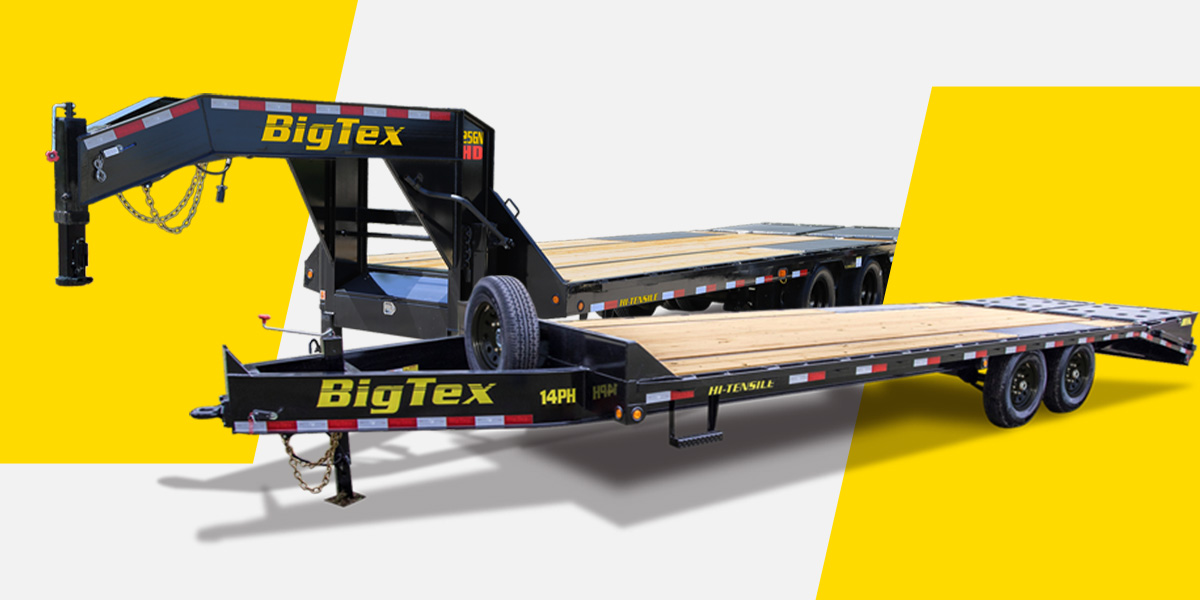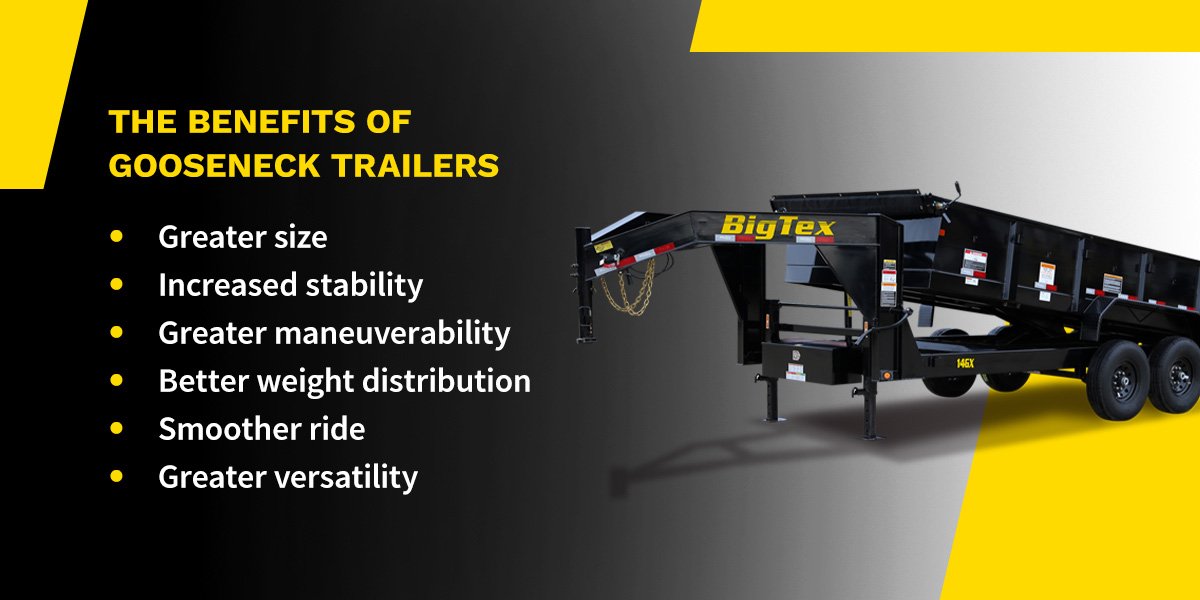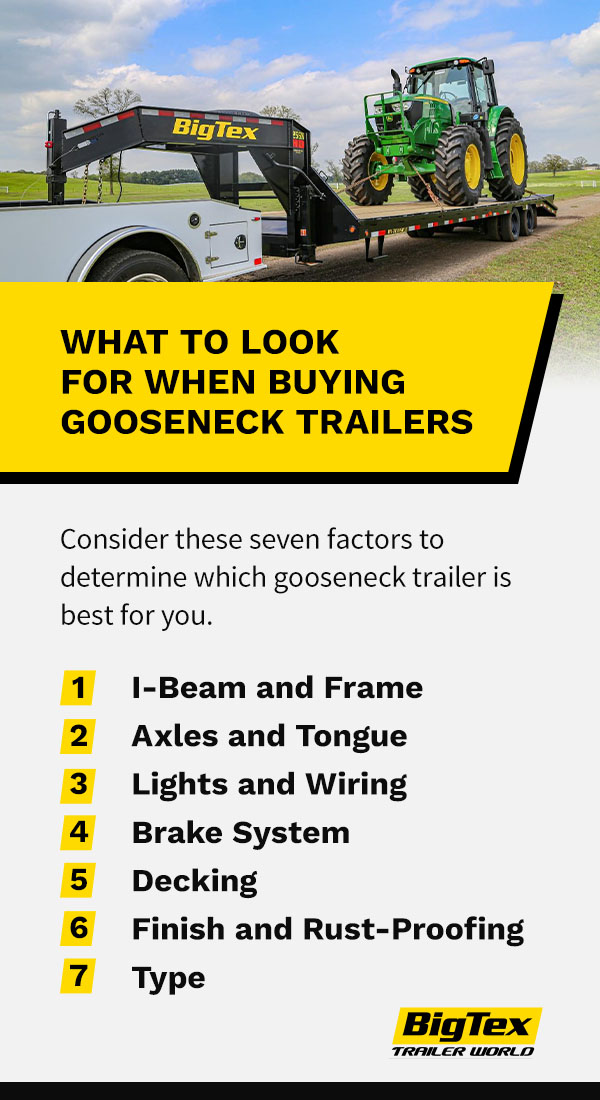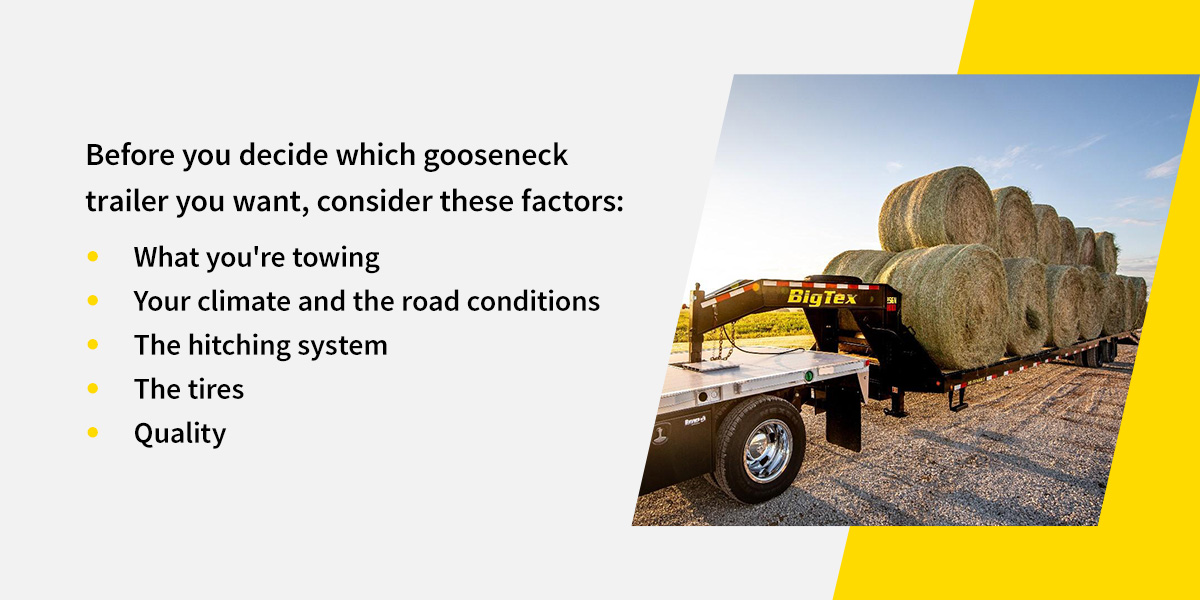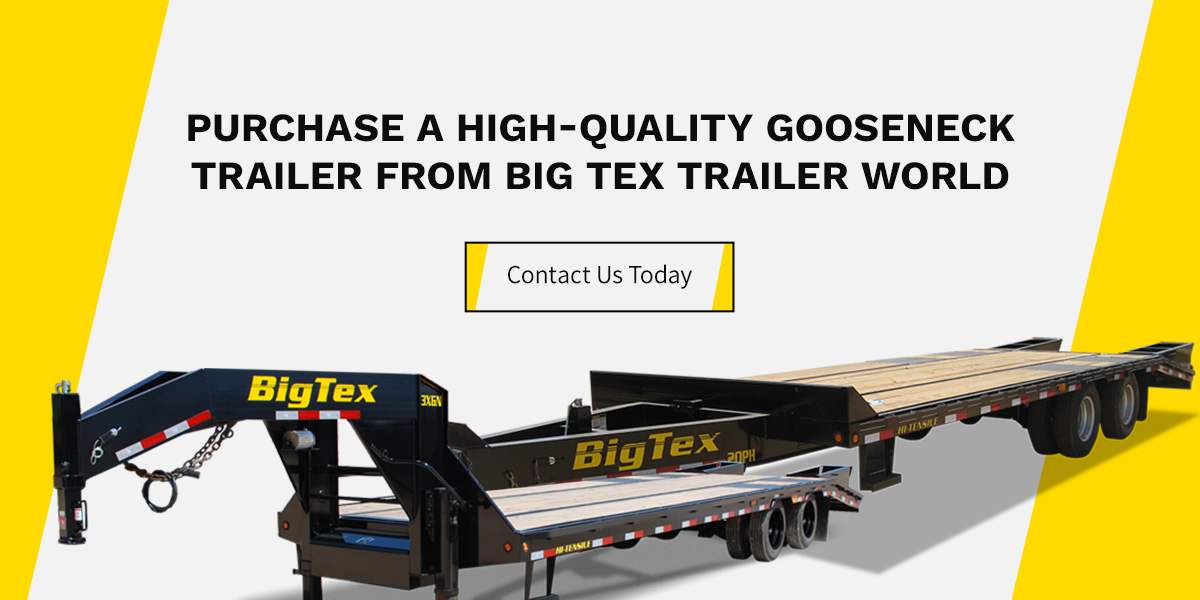Gooseneck trailers are a popular choice when you need a versatile and durable trailer. They can haul small, heavy or bulky loads thanks to their solid frames and expansive beds. These trailers are unique because of their hitching system, which you install in a truck bed. Due to this, they’re also more stable than bumper-pull trailers.
Once you know you want to buy a gooseneck trailer, it’s essential to determine what kind best suits your needs. Learn more about gooseneck trailers and what you should look for when purchasing one.
What Is a Gooseneck Trailer?
Gooseneck trailers are large non-commercial trailers. They have multiple axles to support a higher weight capacity. These trailers also come in various lengths and widths, so they can handle different weights.
Due to their size, people often use gooseneck trailers to transport livestock or equipment. The name refers to the neck of the trailer’s tongue, which resembles a goose’s neck as it arches over the tailgate to connect with the hitch system in the truck’s bed. You install the hitch system beneath the truck’s bed. The safety chain anchor points and the ball are the only parts visible in the bed.
Standard features of gooseneck trailers include:
- A curved, long “neck” that connects to the hitch in the truck’s bed
- Even weight distribution over your truck’s rear axle
- A large hitch that improves stability by reducing sway
- The ability to haul heavy or small loads over long or short distances
- A tighter turn radius because the truck and trailer move in the same direction
The Benefits of Gooseneck Trailers
You can use a gooseneck trailer for professional and personal reasons — maybe you want to haul an ATV to an off-road location or heavy materials and equipment to a job site. Whatever the reason, these trailers provide many benefits:
- Greater size: Gooseneck trailers can be 20-40 feet long. Their size allows them to safely transport loads weighing 14,000-25,000 pounds. A greater hauling capacity enables you to carry more in fewer trips. Plus, because they’re bigger trailers, gooseneck trailers have more room for extra storage, dressing rooms or living quarters.
- Increased stability: These trailers are less likely to sway, even on windy roads or in the wind, and if they do, they’re easier to correct. The overlap between the trailer and truck at the rear axle ensures any lateral pressure from turns travels through the tires and into the ground. Additionally, it keeps the tongue weight on the rear axle to further improve its balance.
- Greater maneuverability: You can take sharp turns with a gooseneck trailer because it sits closer to your truck, so they turn together. With greater maneuverability, backing up, taking U-turns and fitting into narrow parking spots are more manageable.
- Better weight distribution: Between 20%-25% of the load’s weight should rest on the gooseneck’s tongue. Resting that much weight on the tongue helps to balance the load evenly. A well-balanced load makes towing smoother and less stressful.
- Smoother ride: Towing is easier because the trailer’s weight rests on the rear axles. When there’s any turbulence, it travels down the truck bed and into the rear tires.
- Greater versatility: Gooseneck trailers can haul different types of loads. They don’t have to haul heavy loads — they can also haul small or wide loads.
What to Look for When Buying Gooseneck Trailers
Gooseneck trailers are available in various sizes and specifications with multiple standard and unique features. Thus, many buyers need help figuring out where to start when shopping for a gooseneck trailer.
Most gooseneck trailers are flatbeds you can haul with a pickup truck. Others are enclosed to transport livestock, automobiles or utility tools and equipment. Consider these seven factors to determine which gooseneck trailer is best for you.
1. I-Beam and Frame
One of the first things you should inspect is the I-beam, which is the inside cross beam of the deck. The I-beam determines how much pressure per inch the trailer can support. In other words, the smaller the I-beam measurement, the less weight the trailer can handle. So, you’ll want to choose a small I-beam for standard use and a longer I-beam for a heavy-duty trailer.
Also, check the frame to see if it seems sturdy. Ensure there isn’t any damage like dents. Consider what you want the frame’s material to be. Most gooseneck trailers are steel and aluminum. Steel is strong and durable but prone to rust, while aluminum is rust-resistant and lightweight, so it can provide better fuel economy for larger cargo loads.
2. Axles and Tongue
When the load’s weight is more significant, more axles are necessary to transport it. For example, a single axle can haul a light load over a smooth road, but you’ll need multiple axles to transport heavy cargo over a bumpy road. Consider the weight of the product you’ll be hauling to determine how many axles you’ll need.
Aside from the number of axles, you must consider their arrangement. An out-of-place axle puts excessive strain on the hitch. Additionally, there are different types of axles — stationary and hydraulic. Hydraulic axles can lower the bed, so loading is more accessible.
Lastly, look at the trailer’s tongue. If it’s too short, turning might be more challenging.
3. Lights and Wiring
Newer trailers use LED lights over incandescent lightbulbs. Most people prefer LEDs because they’re encased in a wiring harness, long-lasting, energy-efficient and brighter. Also, enclosing the LEDs and wires prevents moisture-related corrosion.
4. Brake System
The Federal Motor Carrier Safety Administration requires trailers with a gross weight of 3,000 pounds to have brakes. Your state may have more specific requirements.
Either way, gooseneck trailers have one of three braking systems — electronic, air or hydraulic. Trailers that weigh more typically have a hydraulic braking system to better handle the weight of the trailer and objects because they’re more powerful. Hydraulic brakes are also best for transporting fragile items.
Electric brake systems are standard on smaller trailers because they’re reliable and require little maintenance. Air brakes are common on large commercial vehicles. They use compressed air to operate the brakes.
5. Decking
You want to select your decking based on your budget and what you intend to transport with your trailer. The trailer deck can be:
- Oak: Oak is a rougher wood, so it’s ideal for carrying heavy loads. However, when professionals treat it, its hardness prevents it from absorbing all the treatment. Therefore, it’s susceptible to rot and decay.
- Southern yellow pine: Southern yellow pine is an excellent cost-effective choice for hauling lighter loads. It’s not as rough as oak, so it can twist or warp. However, unlike oak, it absorbs the chemical treatment to resist decay.
- Aluminum: Aluminum resists corrosion and can handle large loads, but it’s more expensive than steel.
- Steel: Steel is stronger and more affordable than aluminum but requires regular maintenance to prevent corrosion and rust.
6. Finish and Rust-Proofing
Your trailer’s coating helps protect it. If you opt for a powder coating, it lasts longer and can better tolerate wear and tear. It’s also more resistant to corrosion that can cause scratches and chips.
Powder coating doesn’t prevent a trailer from rusting — you must invest in a rust-proof coating to prevent rust. Investing in a rust-proof coating is an excellent idea if you live in an environment with high levels of moisture or humidity that can cause rust.
7. Type
Gooseneck trailers haul equipment, but there are various types for different jobs. The two most common types of gooseneck trailers are:
- Flatbed: Flatbeds are an excellent choice for transporting bulky items. The trailer can be single or dual wheel — single wheels have a lower maximum weight capacity than dual wheels.
- Dump: Heavy-duty dump trailers are great for hauling waste and debris from construction sites and dumping it.
Gooseneck Trailer Buying Tips
The sheer availability of gooseneck trailers affords you many options. Before you decide which gooseneck trailer you want, consider these factors:
- What you’re towing: You need to consider what you’re towing to determine what size trailer you need. Gooseneck trailers have different weight capacities and lengths. For instance, a furniture mover needs a longer trailer that can hold more weight than someone transporting hay.
- Your climate and the road conditions: Your trailer needs to handle the daily wear and tear specific to your area, such as humidity, potholes and dirt roads. Consider your climate and road conditions before you choose a trailer so you can select one that’s durable enough.
- The hitching system: Bumper-pull and gooseneck are two common types of trailers. One of the primary differences between the two is how they connect to a towing vehicle. You install the hitching system for a gooseneck trailer in the bed of a pickup truck, so you must have a pickup truck to tow a gooseneck trailer.
- The tires: Tires are an essential component of your trailer. If they aren’t the right size, the maximum weight limit decreases. Aside from their size, you’ll want to consider their condition. Look for signs of use or damage.
- Quality: A high-quality gooseneck trailer will last many years with routine maintenance and repairs. The better the quality, the better the durability and stability.
General Tips
Once you’ve found the perfect gooseneck trailer for you, here are some tips to help you get the most out of your investment:
- Remember proper leveling: A gooseneck trailer must sit level with your towing vehicle to distribute the weight evenly through all tires and axles. Axles and tires have weight ratings, and you’ll exceed them if more weight is on one or more of the axles or tires. Exceeding the weight ratings can cause tire blowouts and broken axles.
- Get the right height: Gooseneck trailers fit specific truck sizes. For example, your vehicle may be too high to fit underneath certain gooseneck trailers, especially if the trailer is older and your truck is newer. Ensure your trailer can correctly sit on your towing vehicle with the required amount of clearance.
- Choose an adjustable coupler: An adjustable coupler lowers and raises the nose to keep it level on different truck bed heights. If the truck bed is too short, the gooseneck’s nose can hit the truck’s cab when turning.
- Use the safety chains correctly: Attach the safety chains to the sides of the coupler’s plates. They keep the trailer from ramming into the back of your towing vehicle or falling off the back if it disconnects from the ball.
- Use the coupler latch: Remember to latch the coupler so you can safely tow your trailer.
- Clean your trailer: A clean trailer looks sleek and allows you to notice minor problems before they become significant. For instance, you can inspect the bolts for signs of rust or damage. Additionally, cleaning the trailer prevents the frame and gears from corroding.
- Reapply axle grease: You may need to reapply grease to your axles annually, depending on how often you use your trailer and what you use it for.
- Check the air in your tires: Your tires must have the recommended amount of air in them to safely tow your load.
- Inspect the suspensions: Check for loose or missing bolts and uneven tire wear. Also, grab the axle and try to wiggle it. If it barely moves, your suspension is good.
Purchase a High-Quality Gooseneck Trailer From Big Tex Trailer World
When you need a gooseneck trailer for your business or for personal use, you want the best of the best. Choosing a high-quality gooseneck trailer ensures it can sufficiently meet your needs. Whether you need to transport a farm product, furniture or dirt, Big Tex Trailer World has the perfect trailer for you.
Big Tex Trailer World has over 20 years of experience selling, reinventing and servicing the best trailers for our clients. We have the largest selection of like-new and new trailers, accessories and parts. If we sell you a trailer, it’s with the intention of meeting your needs every step of the way — before, during and after the sale. Plus, our experienced staff can service any trailer — whether you purchase it from us or not.
Additionally, our staff will work to understand your needs, so they can offer you what would suit you best. We’ll never attempt to persuade you to purchase something you don’t want or need. Contact us today to learn more about our gooseneck trailers, or call us at 660-358-1222 to speak with one of our expert team members.
